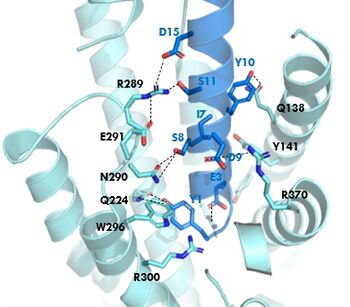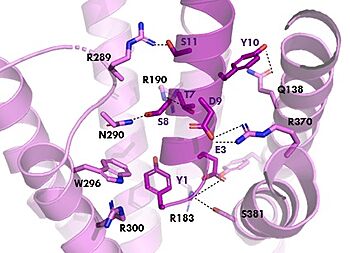User:Chloe Tucker/Sandbox 1
From Proteopedia
(Difference between revisions)
| Line 27: | Line 27: | ||
=== Isoleucine vs. Threonine === | === Isoleucine vs. Threonine === | ||
In GIP there is an Isoleucine present <scene name='10/1038815/Gip_ile7/1'>(I7)</scene>. Isoleucine is a branched residue that is very hydrophobic. This residue is also present in the N-term where the important interactions are occuring. In Tirzepatide, this seventh residue has been changed to a Threonine residue <scene name='10/1038815/Tirzepatide_thr7/2'>(T7)</scene>. Threonine is also a branched residue, but it contains a hydroxyl group making it hydrophilic, allowing it to make hydrogen bonds. This extra hydrogen bond in Tirzepatide is also responsible for a higher binding affinity for the drug than GIP itself. | In GIP there is an Isoleucine present <scene name='10/1038815/Gip_ile7/1'>(I7)</scene>. Isoleucine is a branched residue that is very hydrophobic. This residue is also present in the N-term where the important interactions are occuring. In Tirzepatide, this seventh residue has been changed to a Threonine residue <scene name='10/1038815/Tirzepatide_thr7/2'>(T7)</scene>. Threonine is also a branched residue, but it contains a hydroxyl group making it hydrophilic, allowing it to make hydrogen bonds. This extra hydrogen bond in Tirzepatide is also responsible for a higher binding affinity for the drug than GIP itself. | ||
| - | <scene name='10/1038815/Tirzepatide_thr7/2'>Threonine 7</scene> | ||
Revision as of 14:09, 25 April 2024
GIP and GIP-R
| |||||||||||
References
Student Contributors
- Chloe Tucker
- Mandy Bechman


